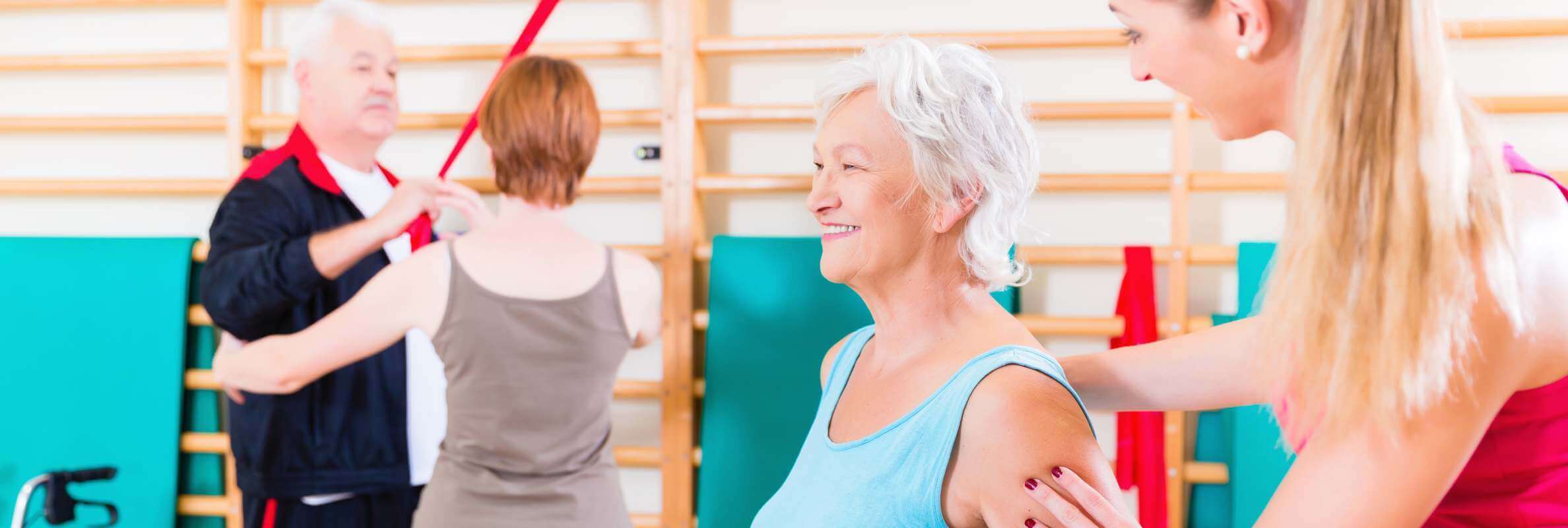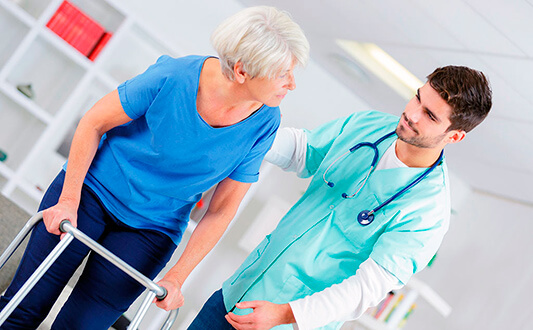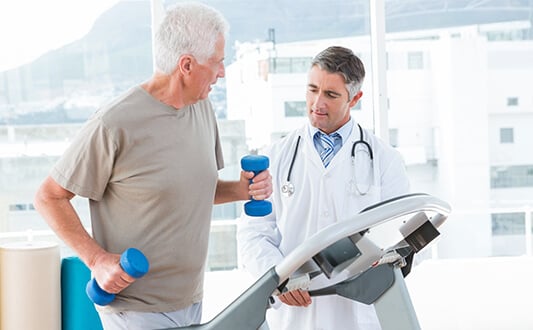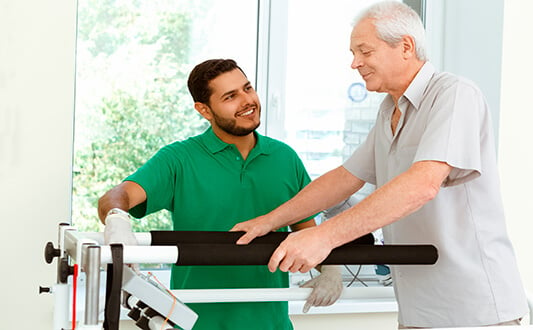Neurological rehabilitation is a complex of therapeutic measures aimed at restoration of person’s working capacity or ability to fulfill activities of daily living without assistance after a disease or surgery. Children with cerebral palsy, patients of mature age with strokes and brain injuries, age patients with Parkinson's disease and movement disorders visit rehabilitation centers.
Human body has reserves for recovery. Chances of return to the full life increase significantly if a patient undergoes course of neurorehabilitation. If the treatment approach is right, new interneuronal and neuromuscular connections can be formed in brain and spinal cord. This allows a person to regain lost functions fully or partially.
When neurological rehabilitation should be carried out
Neurological rehabilitation is an essential component of recovery after operations on the nervous system. It is also carried out in various pathologies, such as:
- Traumatic brain injuries
- Stroke
- Tumors of brain and spinal cord
- Cerebral palsy
- Polyneuropathy due to the alcohol intoxication, diabetes, etc.
- Multiple sclerosis
- Amyotrophic lateral sclerosis
- Parkinson's disease and tremor of different origin
The first step in elaboration of a medical program is establishing suitable for the patient rehabilitation phase based on the Barthel index . The Barthel index, or the daily activity index, takes into account patient's ability to eat, take a bath and perform hygienic procedures, control urination / defecation and use the toilet, move within the bed, walk on a flat surface and up the stairs.
According to the results of neurological check-up, instrumental examination (CT, MRI, neurophysiological examinations) data and calculation of the Barthel index, the following neurorehabilitation phases are identified:
- Phase A – rehabilitation in the acute phase of the disease when a patient is under constant monitoring in the intensive care unit.
- Phase B – early rehabilitation in patients with the Barthel index under 25. It is carried out on an inpatient basis, but the patient may already stay in a usual room, not in the intensive care unit.
- Phase C – the follow-up rehabilitation that is carried out in patients with the Barthel index of 35-65. In this phase, a patient receives therapy on an outpatient basis, without mandatory 24-hour stay in the hospital.
- Phase D – final, supportive rehabilitation that is carried out in patients with the Barthel index of 70-100. Phase D neurorehabilitation is followed by the recommendations for maintenance therapy at home.
Purposes and possible treatment results depend on the severity of the pathology and the degree of central nervous system damage. Some patients manage to achieve full recovery. In other situations, acquiring ability to fulfill activities of daily living without assistance is considered to be a good result.
Neurological rehabilitation techniques
A wide range of neurorehabilitation techniques allows doctors of German hospitals to follow the principles of qualitative rehabilitation carefully, namely:
- Complexity – use of complementary recovery procedures
- Multidisciplinarity – specialists of different profiles take part in the rehabilitation process
- Control – constant medical observation, assessment of patient’s condition and treatment effectiveness
- Systematicity and duration – schedule of procedures and their duration are selected individually and adjusted to patient's health condition changes
- Staging – gradual increase in the intensity of the therapeutic interventions
Choose a rehabilitation clinic
Physiotherapy and manual techniques
The synergistic reflexology according to Pfaffenrot is one of the integrative (holistic) medicine types which combines acupuncture, osteopathy, chiropractic, manual therapy, and reflexotherapy. The simultaneous use of several types of stimulation enhances their neurophysiological effect – the range of motions in patients with paresis and plegia increases by 45-60%.
The EMG-triggered electrical stimulation begins with determination of the electrical activity of individual muscle groups. In the case of paralysis, the conduction of impulses along the nerve fibers is disturbed, therefore, electrical activity of the affected muscles decreases. During the treatment, these muscles receive additional stimulation from the outside. This helps a patient to make a full movement.
The craniosacral therapy is an alternative medicine method which involves the indirect influence on the brain and spinal cord through the engagement of the bones of back and skull. Lightly touching the body, the craniosacral therapist works with the dura mater that covers the brain and spinal cord. The result of this work is the improvement of the cerebrospinal fluid movement and the restoration of patient's neurological functions.
The kinesiology is a branch of medicine that studies the response of skeletal muscle tone to pathological changes in the internal organs. During the initial examination, kinesiologists investigate the force of muscles contraction in response to the physical load. The lack of adequate muscle response is a sign of dysfunction of bone structures, nerve endings, and internal organs. After their correction, a patient notes an appreciable improvement at all levels.
The Castillo-Morales method combines orofacial and neuromotor therapy for the treatment of patients with speech, swallowing, and breathing disorders. Therapeutic gymnastics in combination with acupressure of trigger points, face and neck massage, as well as vibration influence, improves blood flow in the face and neck region. Due to this method, a patient restores speech, ability to swallow saliva, and eat.
The PNF-method (proprioceptive neuromuscular facilitation) affects proprioceptors which are present in muscles and ligamentous apparatus. With the help of the therapeutic influence on these receptors, it is possible to stimulate or facilitate performance of any movement. This increases muscle strength and improves coordination of movements. Patients become more independent in everyday life, they do not require any assistance from others.
The hydrotherapy is a complex of water procedures, including contrast shower, special baths, swimming exercises, etc. Contrast showers and baths with healing supplements promote muscle relaxation and normalize work of the peripheral nervous system. Exercises in the pool allow patients to expand the range of motions because in the water it is much easier for patients to perform certain actions with their hands or to learn to walk again.
Various types of massage (including the vibrating massage and hydromassage in special baths). Massage enhances blood flow intensity, mechanically stimulates joints and muscles, slows down tissue atrophy, and triggers regeneration processes. This eliminates pain; a patient becomes able to move easier and to work with his hands. Hydromassage also increases protective function of the skin and helps to cope with overweight.
Lymphatic drainage (or lymphatic drainage massage) is performed manually, by hardware or by vacuum method. Most neurological patients have difficulties with walking or physical exertions. In such a passive state, the lymph stagnation develops. Movements of the masseur restore normal flow of the lymph through the vessels. This, in turn, improves metabolic processes between lymph and extracellular fluid, normalizing nutrition of muscles and joints.
The fangotherapy (mud therapy) is carried out with the use of mud of organic and mineral origin. The mud is applied locally, in the form of applications, or in the form of full body mud wrap. During the procedure, muscles, joints, and ligaments are deeply heated, and blood flow to them is enhanced. Mineral composition of the mud stimulates metabolism in tissues and relieves pain.
Cognitive techniques
Ayres' Sensory Integration allows cerebral cortex to perceive and process signals from the sense organs better. Additional brain stimulation improves hearing, vision and sense of smell. Classes are provided in a game manner, when not only special devices are used as the additional stimuli, but also any other suitable for a patient tools (mirrors, fitness balls, hammocks).
Perfetti Method helps patients with brain lesion to regain control of movements. At first, patients do simple movements, if necessary with support of an instructor. As their state improves, an instructor selects more complex cognitive exercises, fully restoring fine motor skills and patient's ability to fulfil everyday tasks.
Brain-Gym is a set of exercises aimed at restoring the harmonious interaction of brain neurons, patient's body, and his emotions. It is based on the concept of sensorimotor intelligence. Brain-Gym consists of 26 exercises for the restoration of balance, control of movements, ability to interact with other people in the social environment.
The Doman-Delacato technique or "patterning" is used in various modifications for the early development of healthy children and rehabilitation of children with mental retardation due to the diseases of central nervous system. During treatment, the Doman cards that contain words, pictures, or abstract figures are shown to children. Visual information stimulates work of healthy brain parts and forms new connections between neurons.
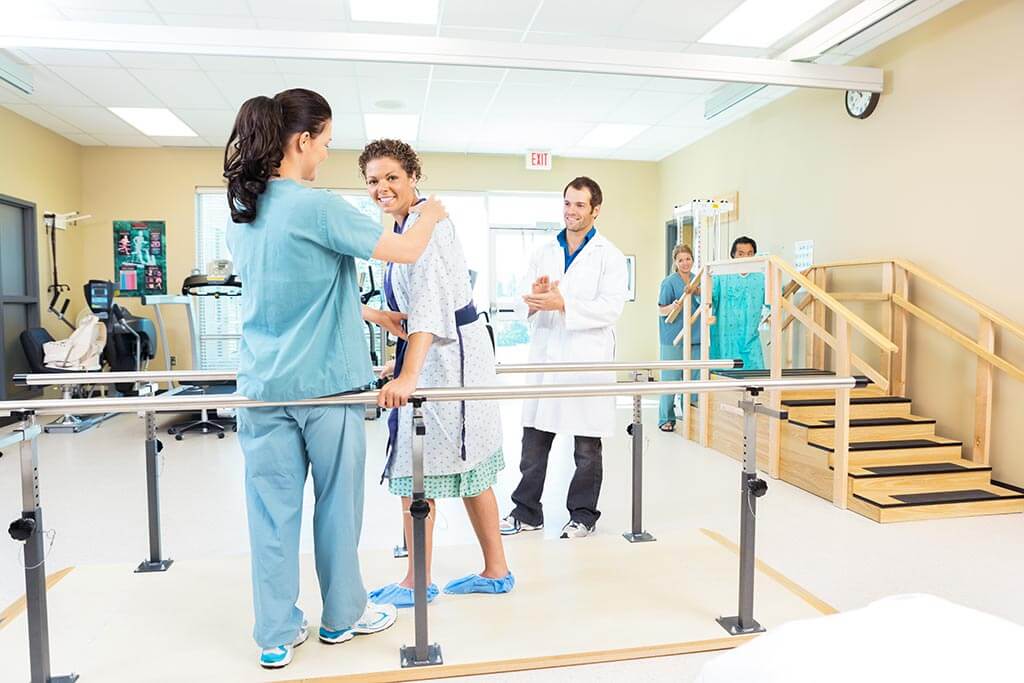
Physical exercises
Affolter rehabilitation method helps patients to become more independent in everyday life. At the initial stage, an instructor passively does necessary actions with patient's hands, forming the correct motor stereotype. Such a contact with the environment forms the foundation for restoration of self-care skills, and subsequently a patient does movements without any assistance.
Basal stimulation is used for the correction of significant movement disorders and defects of the musculoskeletal system. The technique includes a complex of sensory (based on touch and tactile sensations) exercises that helps patients to perceive their own body adequately, to orient themselves in space, and communicate with other people. Basal stimulation reduces feeling of anxiety and allows patients to overcome appearance-related complexes.
The Bobath concept (Bobath approach) is a set of exercises and stimuli (for example, sounds, visual images, touches, body positions) that activates damaged structures of the brain and spinal cord. Sequence of exercises imitates natural stages of the nervous system development during growing up. Therefore, a normal motor stereotype is formed and pathological movements cease in patients.
Brugger method strengthens superficial and deep muscles of back, forms the correct posture. Brugger exercises include movements with arms, due to which back is reflexively straightened. After fixing the correct posture, functions of the spinal nerves are restored (they are no longer compressed in the spinal canal), body position and muscles work are normalized.
Alexander technique is aimed at correction of the position of vertebrae, ligaments and muscles of the neck. According to the author of the method, common in neurological patients violation of the natural head and neck position leads to profound disturbances in state of spine, muscles, and internal organs. Removal of clamps in the neck with a set of exercises improves general condition of a patient.
The Feldenkrais method is a system of conscious and thoroughly controlled movements. A patient fulfils simple actions (for example, raises a hand, tears off a foot from the floor, tilts his head) extremely slowly, a movement can be absolutely imperceptible from the side. However, attention of a patient is fully focused on the working part of the body. Exercises do not require significant physical efforts and involve all parts of the brain.
Vojta therapy is a technique of reflex therapy, aimed at the activation of motor reflexes with the help of external influences. During the treatment, a patient is lying on his stomach and a doctor repeatedly induces the unconditioned reflexes (namely, those ones that function even in the nervous system damage) – crawling and turning over reflexes. In case of responding to the stimulation, a patient unconsciously uses the muscles of spine, arms, and legs. In a multiple repetition of such actions, disturbed nervous connections between brain and muscles are restored.
Ergotherapy is used in patients with disturbed adaptation to independent life and professional activities. The main purpose of therapy is to restore maximal normal function of the upper limbs or to teach the patient how to work with aids (these can be orthoses, devices for cooking or working with a computer). The occupational therapist carries out psychological work, helping the patient to accept new living conditions.
The Klein-Vogelbach method is a system of physical exercises with a fit ball (inflatable ball). During the therapy, a patient does active and passive movements which allow him to use all muscle groups without undue stress on the spine and joints. The technique helps to get rid of pain and increase the range of movements of the shoulder girdle, thighs, knee joints, and spine.
Klapp gymnastics – "Klapp's crawling" redistributes load on the muscles of the body. In the position on all fours, back muscles do not need to strain and hold body vertically, as muscles of arms and legs are engaged in the work. In such conditions, spine becomes more flexible and restores its natural shape. Thorax deformities can be corrected in the same way.
TAMO therapy is a technique which was developed by the Tscharnuter Akademie for the Motor Organization (hence the abbreviation is TAMO). It is used in children with neurological and orthopedic disorders of motor function. Under the guidance of an instructor, young patients perform special movements which restore the connection between brain and muscles. At the same time, the excessive movements (hyperkinesis), often observed in neurological patients, are excluded.
Tsilgraif therapy is a complex technique which combines yoga-based exercises with a special breathing system. Exercises do not require special physical training and excessive muscle tension. Tsilgraif therapy can be administered to patients of all ages.
Exercises for pelvic floor muscles – Kegel exercises help to restore function of pelvic organs in men and women. It is especially important for the patients with impaired sensitivity of the lower part of the body or paralysis / paresis. Systematic performance of a set of exercises under the guidance of an instructor helps to control urination and defecation, improves sexual function.
Art therapy and psychological support
The classes according to Peto . The technique of Prof. A. Peto from Hungary combines elements of psychotherapy with orthopedic and neurological rehabilitation. It is used to improve the psychomotor and emotional development in children. The classes are held individually or in small groups.
Hippotherapy is a set of physical exercises which is done with a specially trained horse, under the supervision of an instructor. Hippotherapy is used in the rehabilitation of patients with physical and mental diseases (cerebral palsy, autism, delayed speech and mental development). The therapy with horses improves balance and coordination of movements, normalizes muscle tone, and gives patients positive emotions.
Music therapy can act as a preparation for the deeper psychological practices or can be an independent method of neurorehabilitation. There is an active direction in music therapy, when the patient works with a musical instrument, and a receptive direction, when it is enough to listen to melodies attentively. Depending on the choice of composition, music therapy helps a patient to relax or, conversely, improves concentration.
Art therapy shows the inner feelings and problems of a person through the external images. This is a psychotherapeutic technique which uses drawing, modeling from plasticine, or clay, creating collages to reveal hidden fears of neurological patients and increase their motivation for the treatment.
Choose a rehabilitation clinic
Leading German hospitals and specialists in neurorehabilitation
German experts attach great importance to the full recovery of patients, so neurological rehabilitation can be provided in many German hospitals. It is better to contact large centers which are equipped with everything necessary for individual rehabilitation activities.
Rehabilitation in Germany implies:
- Vast experience of German doctors in the recovery of neurological patients
- Early initiation of therapy and prolonged maintaining courses
- Staying in comfortable living conditions adapted to the needs of neurological patients
- Individual rehabilitation programs
- Equipment of hospitals with the latest medical technologies
When choosing a hospital, you should pay attention to medical institutions with the highest effectiveness rates at first. These hospitals are:
- Neurological Rehabilitation Clinic Godeshöhe, Bonn , has over 30 years of experience in the rehabilitation of patients with neurological diseases. In addition to the general department of neurological rehabilitation, departments of spinal injury, neurourology, and rehabilitation in multiple sclerosis are functioning here. On the basis of the medical institution, patients can undergo rehabilitation of phases B, C and D, namely, receive a treatment on an outpatient or inpatient basis. The clinic closely cooperates with university hospitals of Bonn and Cologne on professional and scientific levels.
- According to the Focus magazine in 2017, St. Mauritius Therapy Clinic, Meerbusch , ranks among the top rehabilitation clinics in Germany. Specialists clearly divide treatment methods depending on the age of patient. Pediatric, general neurological and gerontological neurorehabilitation is offered here. Such approach gives the maximum result in children with cerebral palsy, adult patients with traumatic brain injuries, and the elderly patients with age-related changes in the brain. Also, the clinic provides early rehabilitation for patients in the state of minimal consciousness. This is a part of the phase B neurorehabilitation which requires special professionalism from the doctors.
- Maternus Rehabilitation Clinic, Bad Einhausen , admits patients for the earliest rehabilitation, neurorehabilitation of phase A, which usually takes place in the conditions of the intensive care unit. Patients with extensive strokes and brain operations come here for an active recovery including weaning from the artificial lung ventilation. Together with the Department of Orthopedic Rehabilitation, doctors help patients to restore the muscle tone and learn to walk again. High level of medical services is confirmed by the international certificate DIN EN ISO 9001:2008, which is given only to the best rehabilitation centers.
- Neurological Rehabilitation Clinic RehaNova, Cologne , specializes in recovery after the organic lesions of the brain and its vessels (for example, in stroke, traumatic brain injury, meningitis, tumors). On the basis of the clinic there are several rehabilitation units of narrow specialization. This is a section for intensive care and patients on artificial lung ventilation, a section for patients with spinal cord injuries, a section for consolidation of the outpatient rehabilitation phase D. The clinic also regularly organizes training seminars and psychological events for family members. The clinic has received the prestigious certificate EN ISO 9001-2008 for the high quality of work.
- MEDIAN Rehabilitation Clinic Berlin Kladow is the first specialized center in Berlin that has been admitting patients with pathologies of the brain, spinal cord and peripheral nerve endings for over 30 years. In particular, patients with different brain pathologies can undergo neurological rehabilitation of phases B and C here. The medical team combines drug treatment, physiotherapy, instrumental therapy and other therapeutic methods. Thanks to the excellent equipment and high professionalism of the healthcare professionals, the clinic has the DIN EN ISO 9001:2015 quality certificate. The center is also accredited by the German Society of Neuropsychology.
How can I undergo rehabilitation in Germany?
It is usually difficult for a person to go to Germany for a treatment because of the following conditions:
- A person has health problems or has recently had a surgery
- A person does not speak German
- A person often does not have any documents for traveling abroad and does not know how to execute them
- A person does not know which documents, including the medical ones, should be taken with him
- A person does not know where the German hospitals are located, and how to contact them from other countries
- A person does not understand how a foreign patient should communicate with the clinic administration about the rehabilitation program
- A person cannot move freely in a foreign country, because he does not orientate in it
- A person does not know how to get to the destination – to the right country, right city, right clinic, etc.
- A person does not understand what rights he has in a foreign country, and how to cope with various non-standard situations
- A person does not have any information about his rights in the clinic, does not know what he can claim, whether he got everything he needs, what he has paid for, etc.
That is why international patients receive treatment in the leading German rehabilitation centers with the assistance of a certified medical tourism operator – Booking Health . The specialists of Booking Health are the certified doctors who have long experience in neurological rehabilitation in patients of all ages. Also, Booking Health is a team of professionals who knows all the subtleties of the organization of treatment for foreign citizens and will accompany you at all stages.
Booking Health offers help in such important aspects:
- Choosing the right clinic based on the annual qualification profile
- Establishing communication directly with your doctor
- Preparing medical program in advance, without repeating previous examinations
- Providing favorable costs, without overpricing and additional coefficients for foreign patients (saving up to 50%)
- Booking the appointment on the necessary date
- Monitoring medical program at all stages
- Help in buying and forwarding of medicines
- Communication with the clinic after treatment completion
- Control of invoices and return of unspent funds
- Organization of additional examinations
- Offering service of the highest level: booking hotels and plane tickets, transfer organization
In order to begin preparation for rehabilitation, you should leave a request on the official website of Booking Health. On the same day, a medical consultant will contact you to discuss details of the trip.
The Booking Health portal presents 20 German clinics where you can receive Neurorehabilitation (neurological Rehabilitation) — Phase C.
Article menu:
- When neurological rehabilitation should be carried out
- Neurological rehabilitation techniques
- Physiotherapy and manual techniques
- Cognitive techniques
- Physical exercises
- Art therapy and psychological support
- Leading German hospitals and specialists in neurorehabilitation
- How can I undergo rehabilitation in Germany?
Don't know where to start?
Contact Booking Health